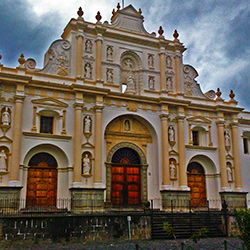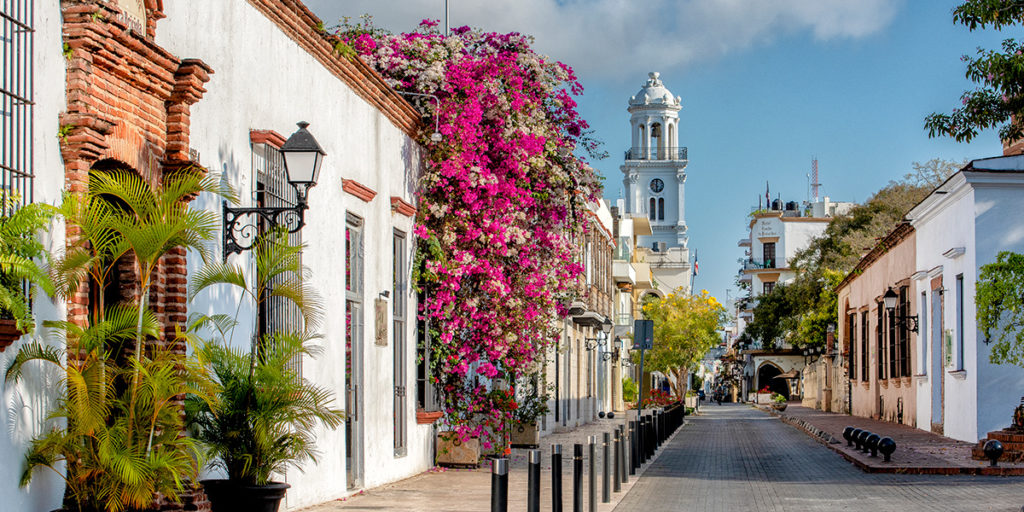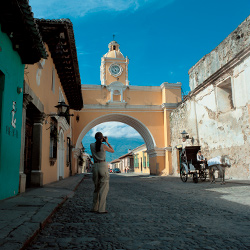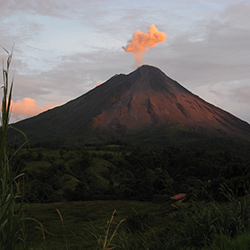Central America is a region with deeply rooted ancestral traditions. Depending on the time of year, life, the dead, the saints, and the harvests are celebrated. Central American traditions include festivities that combine indigenous and Spanish influences, religious festivities, civic festivals and popular festivities. Each city or town also has its own local events, with some distinctive features for each community. Central American popular religiosity revolves around the saints, who are perceived as intercessors between human beings and God. A rich tradition has grown around the celebration of patron saints, with solemn religious festivals laden with popular cultural expressions. The Christmas Eve gathering on December 24, and the religious processions of the Holy Week, are other festivals with a religious background that are traditionally celebrated in the seven countries of the isthmus.
Inicio » EXPERIENCES » Celebrations
FESTIVITIES IN CENTRAL AMERICA
Ancestral tradition and Spanish influence
Belize
New Year’s Day opens the holiday season in Belize. The Carnival Festivities, and the dances of the troupes or comparsas put color, music, and joy into the country. On March 9, Baron Bliss Day is commemorated in honor of the country’s benefactor, celebrated with a regatta and exciting horse and bicycle races. September 10 is the day of St. George’s Caye, celebrated with sporting and cultural events, such as fireworks and concerts. The Mayan practice of Catholicism is characterized by a fusion of shamanism and Christian rituals. The Dugu ritual is an emblematic tradition of the Garifuna practiced in order to heal a sick person, to repair a damaged relationship between ancestors and the living, or to be grateful. During the ritual, dancing and singing to the rhythms of drums, alleged ancestral presences manifest through spiritual possessions, under the guidance of a shaman (buyai). The Dugu ritual takes place in July and August. The belief is that in the afterlife, ancestors have the role to safeguard the harmony and well-being of their living relatives.
Guatemala
Due to its religious tradition, each of the municipalities of Guatemala celebrate the Fiesta Patronal or patron saint feast. This takes place in the week of veneration of the Patron Saint of each municipality, and culminates in the particular day with special celebrations. The Semana Santa or Holy Week is a festival of great artistic value, in addition to religious fervor. The largest processions are held in La Antigua Guatemala, and in Guatemala City. In these, besides the beauty of the platforms, the villagers organize themselves to make alfombras or carpets, which are the main attraction of this celebration due to its artistic details, characteristic of Guatemala, and in turn, attract tourists who observe its detailed elaboration. The carpets are made of sawdust, fruits, flowers and different materials, an expression of faith and color. In Huehuetenango, and other towns in the country, the live representation of the Passion of Christ stands out.
El Salvador
In El Salvador, the patron saint festivities, mostly of religious content, take place in all the municipalities of the country. Usually the feasts, held in honor of a character or saint, begin nine days before the main day, and open with a procession known as the Desfile del Correo, which goes through the town’s main streets accompanied by the old or masked people, music bands, and other people like the mayor, municipal and religious authorities, the queen of the celebration, and the residents. The day before the celebration is usually known as the víspera or eve, and is when most of the activities happen. The San Miguel Carnival in San Miguel, as well as the Fiestas Agostinas in San Salvador, and the Fiestas Julias in Santa Ana, are some of the most important popular celebrations in the country.
Honduras
Throughout the year, in every corner of Honduras, joyful, colorful and fun festivities and Ferias Patronales or Patron Fairs are celebrated, according to the customs and traditions of each place where they take place. In February of each year, thousands of parishioners from all over the country travel to Tegucigalpa to pay reverence to the Virgin of Suyapa, Patron Saint of Honduras, celebrating with the alborada or dawn chorus, music, fireworks, traditional food and much devotion. As popular as this party, although more pagan and colorful, is the Feria Isidra de La Ceiba, which culminates with the Gran Carnaval Internacional de la Amistad or Great International Carnival of Friendship. During the Feria de San Sebastián, the martyrdom of Saint Sebastian is celebrated, better known as the Baile de los Diablitos or Dance of the Devils, one of the oldest religious dramatizations in Honduras, with roots in the Lenca culture.
Nicaragua
Many of the traditions and celebrations in Nicaragua revolve around the Catholic religion, heritage of the Spanish colony. In the fiestas patronales or patron saint celebrations, the idiosyncrasy of the town and its religious fervor are reflected. The gritería, in honor of the Immaculate Conception of Mary, is the most popular religious festival in the country, celebrated in December in all Nicaraguan towns and cities. The patron saint festivities of Santo Domingo de Guzmán in Managua, those of San Jerónimo in Masaya, and San Sebastián in Diriamba, also stand out. Usually, the patron saint festivities are accompanied by cultural expressions such as the Güegüense or Macho Ratón dancing comedy (declared Intangible Cultural Heritage of Humanity); the dances of Los Diablitos, El Toro Guaco, El Gigante, La Vaquita, and Las Inditas; as well as the hípicas or equestrian parades, and the corridas de toros or bullfights. The city of Masaya, cradle of national folklore, also celebrates the Procession of the Agüizotes and the Gran Torovenado del Pueblo, festivities based on myths, legends and popular superstitions. On the Caribbean coast, the festival of Mayo Ya or May Pole takes place, during which the rain and the harvest are welcomed with music and dancing.
Costa Rica
The Costa Rican folkloric traditions includes diverse cultural manifestations that involve music, dance, legends and traditions, bombas and retahílas or string songs, colonial instruments and traditional songs, which are generally used during popular and patron festivities, and which vary according to each region and town of the country. There are some celebrations that reflect the indigenous heritage, such as the Juego de los Diablitos de Boruca in Rey Curré, which takes place at the end of the year in Puntarenas. Some religious festivals reflect syncretisms between indigenous beliefs and the Catholic tradition, such as the Danza de la Yegüita in Nicoya, in honor of the Virgin of Guadalupe, or the Pilgrim Indian Dance during the celebration of the Black Christ of Esquipulas in Santa Cruz de Guanacaste. Among the most important religious celebrations is the Pilgrimage to Cartago to visit La Negrita and thank or ask for favors, in addition to the traditional Pasada de La Negrita. Among the celebrations of folkloric and popular nature, the festivities of Zapote at the end of the year, and the Carnival of Puntarenas or Limón, all with activities such as the traditional Costa Rican Masquerade, topes or horse parades, bullfights and bull riding, and the carreras de cintas or ribbon races.
Panamá
Carnivals are one of the main festivals in Panamá, especially the Carnival of Panamá and the Carnival of Las Tablas, in the capital of the province of Los Santos. The carnivals are celebrated for four consecutive days, before Ash Wednesday. This festivity ends on Tuesday night with the entierro de la sardina or burial of the sardine. The festivities of the Panamanian carnival begin on Friday night with the coronation of the Carnival Queen. Saturday morning continues with the mojaderas or culecos in public or private squares, with tankers that spray water from the river during the day and part of the afternoon, accompanied by popular music. Later at night, there are parades with queens wearing carnival costumes on board of allegorical floats accompanied by comparsas, and tunas or music groups. On Friday and Saturday, following these days of carnival, the derek heines are held, which are considered the town’s own festivities, given that the carnivals are attended by many tourists from other areas of the country and abroad. The Festival Nacional de Manito Ocueño is a folkloric festival held the second week each August, and was declared by law as the National Folk Festival of the Republic of Panamá.
Central America
Get to know the places, spaces, and monuments that make up Central America.
Live Central America!
Enjoy Central America!
CONTACT
Write us. Travel without doubts.
info@visitcentroamerica.com
Call us+503 7016 4711
FB Messenger Visit Centroamérica




